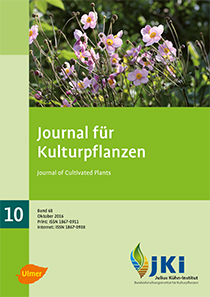First report of aster-yellows disease in carrots and in the leafhopper <em>Macrosteles sexnotatus</em> (Fallén 1806) in Germany – monitoring and diagnosis
Keywords:
Carrots, aster yellows disease, phytoplasma, ‘Candidatus Phytoplasma asteris’, vectors, leafhoppers, Macrosteles sp., monitoring, PCR-based DNA testAbstract
A phytoplasma of the ‘aster-yellows’-group was detected in carrots by the Center for Agricultural Technology Augustenberg (LTZ Augustenberg in the federal state of Baden-Württemberg) in the year 2011. It could be identified as Candidatus Phytoplasma asteris by sequence analysis of the PCR-amplification product. This is the first report about this disease in Germany. Nearly two per cent of the carrots were infected and showed the typical red coloring of the foliage. The roots also showed characteristic symptoms of increased root hairs and abnormal root growth. Therefore, a monitoring-program was started, which lasts from 2012 until 2014 (3 years). The potential vectors, leafhoppers from the genus Macrosteles, were captured by sweep nets and were dedicated afterwards. Furthermore the migration of the leafhoppers was monitored by the use of yellow sticky traps. After that, the captured leafhoppers were investigated by PCR-based DNA test. Within these tests, ‘aster-yellows’ was confirmed in leafhoppers of the genus Macrosteles. On average, 3.3 per cent of specimens collected in the 3 years were infected with ‘aster yellows’ phytoplasma. Within all leafhoppers captured, Macrosteles species extended to about 18 per cent. These species were M. sexnotatus, M. laevis, M. cristatus und M. ossiannilssoni. Thereby nearly 70 per cent of the captured Macrosteles species were M. sexnotatus, followed by M. laevis und M. cristatus, each represented about 15 per cent. Only 2 per cent of the Macrosteles species belonged to M. ossiannilssoni. Within the Macrosteles-leafhoppers which were infected with aster-yellows, 85.7 per cent belonged to the species M. sexnotatus. Therefore it is evident, that the common and wide spread leafhopper M. sexnotatus is able to transmit aster-yellows in Germany. It is very easily to detect leafhoppers in the field by using yellow sticky traps. It is also possible to document the migration of the leafhoppers by using these traps. The period of migration of the leafhoppers lasts from the middle of May to the middle of September. The captured Macrosteles were infected by aster-yellows very early in the season. This means, that the Macrosteles population must have infected itself on different herbs by their migration from their overwintering areas to the carrot fields. Up to now, it is not known, where the Macrosteles species originate from. A migration from the surrounding area is also possible, than the migration from areas far from the carrot fields. It is also unknown, where and on which herbs the leafhoppers infect themselves with ‘aster-yellows’ phytoplasma.
DOI: 10.5073/JfK.2016.10.01, https://doi.org/10.5073/JfK.2016.10.01
Downloads
Published
Issue
Section
License
The content of the journal is licensed under the Creative Commons Attribution 4.0 License. Any user is free to share and adapt (remix, transform, build upon) the content as long as the original publication is attributed (authors, title, year, journal, issue, pages).
The copyright of the published work remains with the authors. The authors grant the Journal of Cultivated Plants, the Julius Kühn-Institut and the OpenAgrar repository the non-exclusive right to distribute and exploit the work.







